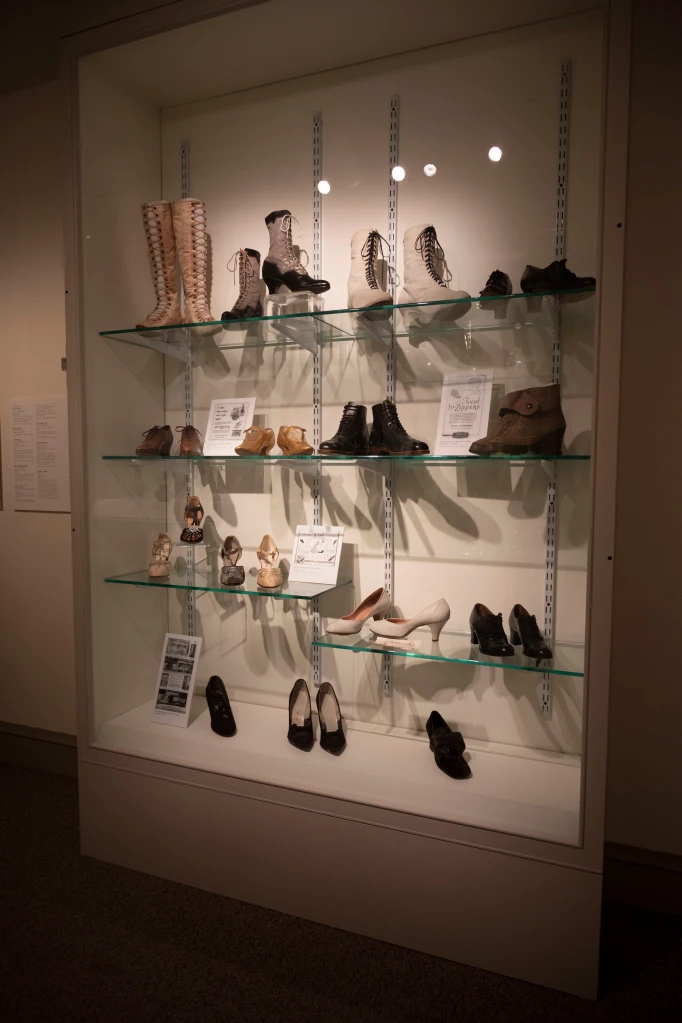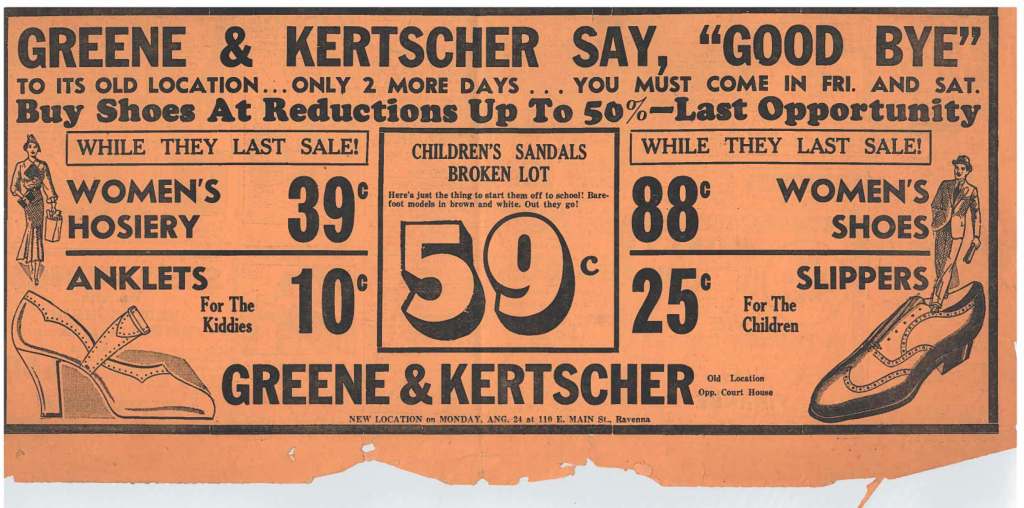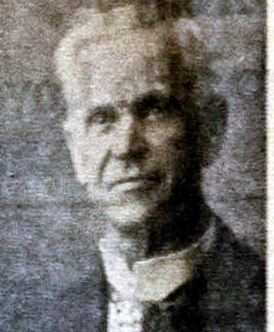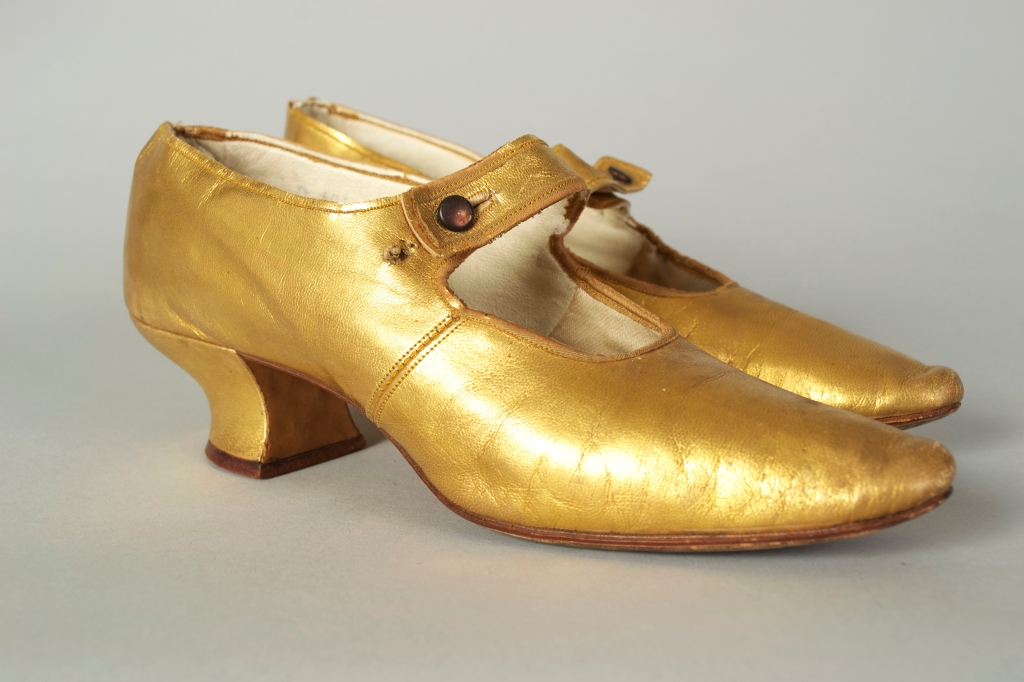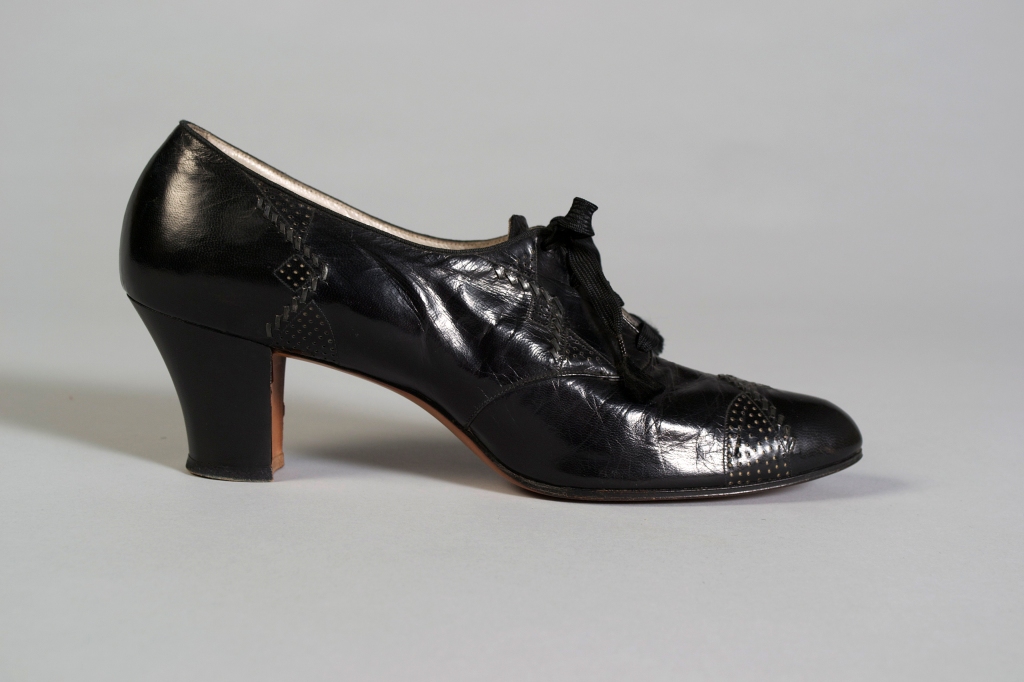My name is Natalie Rizzo, and I am a Museum Fellow for the Kent State Museum. I am a student who works under Dr. Hume, Museum Curator, to research, edit photographs for the collection, dress mannequins, and other jobs that may arise.
One of my recent projects was to work on an exhibition that developed out of an invitation by the Central Portage County Visitors and Convention Bureau to collaborate on a project that tells stories through shoes. The original plan was to feature four categories on four shelves. One was supposed to be baby shoes, another was supposed wedding shoes, and the third would feature shoes of Katharine Hepburn– a large part of whose wardrobe is now part of the museum collection. Finally, the fourth shelf was supposed to be shoes from an early gift, many of which were singles and never worn. Looking into this fourth gift, donated by a local shoe store owner and his wife, Dick and Isabel Kertscher, led to the decision to focus solely on their long-lived Portage County business. This display of shoes from Kertscher’s would tell the story not only of the shoe industry and its reach, but the lives of the owners and their consumers.
Selecting objects for exhibits is done by looking through the online museum database. The objective was to find only shoes that could tell a story, but were also in good enough condition for display and visually interesting. As research about the shoes proceeded, some of these shoes would be swapped out for plainer, but more storied options. Eventually the shoes had to be examined in person, which led to discovery of inscriptions previously not mentioned in the database, such as brand markings. There were 42 shoes in the gift to choose from of which 17 were chosen in the end. The shoes were picked from a range of dates in effort to follow the store’s history but also tell their own stories.
The more interesting story really started with Dick Kertscher’s obituary, which Dr. Hume found online. Dick Kertscher in 91 years led a very full life. He started working at the shop owned by his father and his business partner, C.E. Greene, when he was young. He graduated from high school in Ravenna in 1928 and went to college with the hopes of working in radio or foreign service. He did not originally want to go into shoes, but fate played its hand. Only a month after he graduated from college, Albert, Dick’s father, passed away. Dick decided to take over his father’s share of the business. He went on to run the business for 55 years. However, his life was not singularly centered on shoes. He was a prize rose gardener, an active community member and politician, and a lover of traveling.
With every donation comes paperwork. This paperwork is stored in physical files in an office cabinet. Within the folder there were important information such as Mr. Kertscher’s original description of the objects, how they were first accessioned by the museum, as well as a number of store ads that presumably Mr. Kertscher brought with his gift. These ads were mostly from the late 1950s and early 1960s. This included an a 78th anniversary promotion that had a timeline of the store’s history. Joining the later ads, there were two clippings from the 1930s: one clipping announcing the death of Albert and the subsequent succession of his son and the other announcing the moving of the store from its original location by the courthouse to its final location on main street.
The folder also contained an original interview with Dick Kertscher, done by Renee Ryckman, a former KSU student and museum worker. The problem was it was on a cassette tape. The museum has no way to play a cassette tape, so it needed to be digitized at the Multimedia Center in the Kent State Library. You can listen to these digitized recordings yourself on the exhibition website.
The biggest help in researching was digitized newspaper archives including those of the Kent Tribune, the Ravenna Record Courier and even Women’s Wear Daily. These were a treasure trove of information. In the newspapers I managed to find advertisements for the exact shoes in the collection, as well as important announcements surrounding the store’s history. The Goodrich boots, whose date was previously uncertain, were found to be introduced in 1926, according to an advertisement promoting the new style. The newspapers also corrected some information that was incorrect or incomplete in the Kertscher’s anniversary timeline such as the omission of Rumbaugh, one of the original partners of the store.
In the 1930s the store announced the installation of an x-ray shoe fitter. Dr. Hume was particularly taken aback by this, considering untrained operators and superfluous use of radiation is inadvisable. I had seen one of these before at the National Museum of Scotland, and I was pleased to see one had really been used in our area. A particularly amusing advertisement was the announcement that in 1929 Buster Brown was coming to town with his dog Tige, courtesy of Kertscher and Greene. Tige, was in fact a real dog named Tige. Buster Brown, on the other hand, was actually an adult actor with dwarfism. Busters and Tiges came to lots of towns in that era as a promotion by the Brown Shoe Co. to sell Buster Brown children’s shoes. Another, odd ad had F.P. Chapman, original owner of the store, speaking in third person lauding his own window dressing skills.
The brands themselves also offered interesting stories. One brand, Endicott Johnson, played an instrumental role in American history by pioneering a progressive era concept known as Welfare Capitalism. This would lead to employees having access to a shoe shaped swimming pool. Another label, J. Azzimonti NY, was created by a “poet of the sole” who often made theater shoes and even patented a tap shoe with bells inside.
Unfortunately, with researching lives, comes researching deaths. One particularly distressing article which I stumbled upon by accident was about the death of Herman Kertscher, father of Albert and grandfather of Dick. In 1908 he had met an unhappy end when he was found struck by a train on Thanksgiving morning, in part discovered by his daughter, whose first husband had met a similar end. The article also rather casually mentioned that Herman’s wife had been hospitalized in an asylum in Massillon for the past ten years after the death one of their children. Albert, his son, died less violently, but no less tragically from a sarcoma at around 50. Fortunately, Dick Kertscher would not inherit his family’s misfortune and died naturally in his old age.
To show that research is never truly finished, the next chapter of research– so far– began after the exhibit had already been put up and even after I began writing this blog post. It happened as I was talking about the display to my fellow museum fellow. I had remarked that if you kneel you can see the lack of wear and the markings on several shoes. I then did so and noticed something strange. On the sole of the left foot of the gold shoes from Seaman Smith Co. was an inscription. I had looked those shoes over many times but apparently had only looked at the right one. The inscription said that they had been the shoes of a Mrs. Geo. H Robinson. Verdie Robinson was a prominent woman in Ravenna from an old family that married in the early 1890s, making the shoes thirty years older than previously thought. To add, I also learned of the hazardous tale of Frederick Seymour, Quaker Oats Employee in London and Verdie’s brother. In 1915 he wrote a letter home claiming to have been racing across London in a car while being pursued by a German War Zeppelin, which was bombing the city. The veracity of this story will be left to readers’ judgement.
Quite frankly, a blog post is still not enough space to write all that I have learned during this process. I know more than ever before about early 20th-century Ohio shoe companies, Portage County, the shoe industry, and the histories of former Ravenna residents. More information is on our website about the shoes and store. You can also share any personal stories that you may have of the store and the shoes you purchased there. As for everything else: start researching yourself, you never know what you might find.

